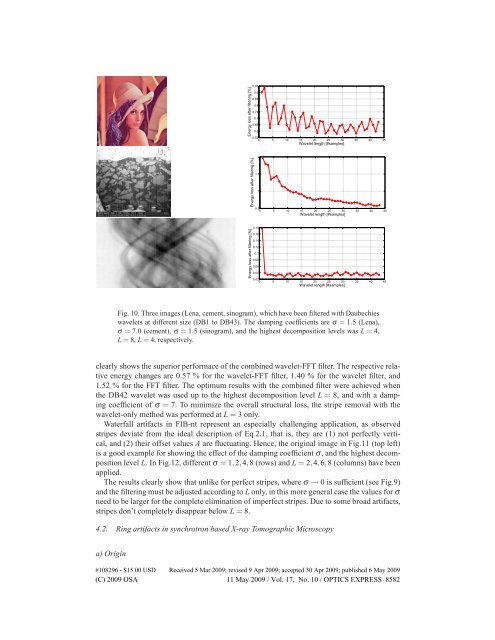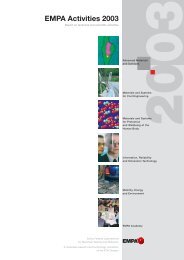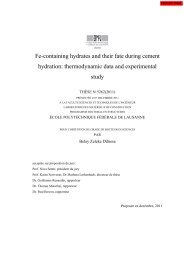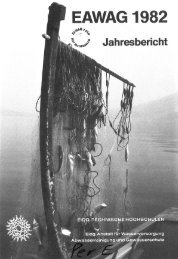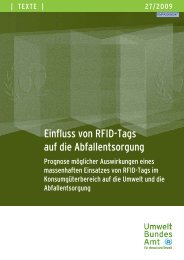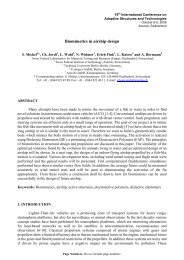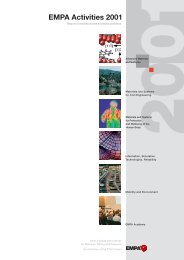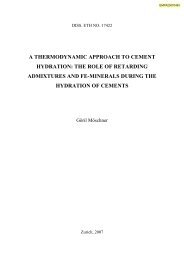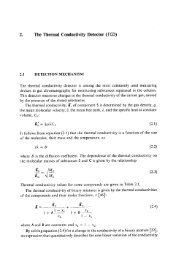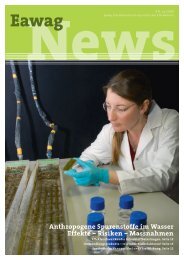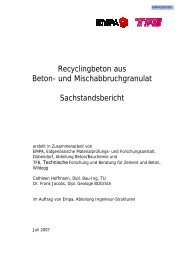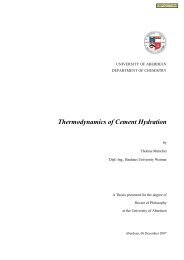Stripe and ring artifact removal with combined wavelet — Fourier ...
Stripe and ring artifact removal with combined wavelet — Fourier ...
Stripe and ring artifact removal with combined wavelet — Fourier ...
Create successful ePaper yourself
Turn your PDF publications into a flip-book with our unique Google optimized e-Paper software.
Energy loss after filte<strong>ring</strong> [%]<br />
0.95<br />
0.9<br />
0.85<br />
0.8<br />
0.75<br />
0.7<br />
0.65<br />
0.6<br />
0.55<br />
0 5 10 15 20 25 30<br />
Wavelet length [#samples]<br />
35 40 45<br />
Energy loss after filte<strong>ring</strong> [%]<br />
Energy loss after filte<strong>ring</strong> [%]<br />
2<br />
1.5<br />
1<br />
0.5<br />
0 5 10 15 20 25 30<br />
Wavelet length [#samples]<br />
35 40 45<br />
0.18<br />
0.16<br />
0.14<br />
0.12<br />
0.1<br />
0.08<br />
0.06<br />
0.04<br />
0.02<br />
0 5 10 15 20 25 30<br />
Wavelet length [#samples]<br />
35 40 45<br />
Fig. 10. Three images (Lena, cement, sinogram), which have been filtered <strong>with</strong> Daubechies<br />
<strong>wavelet</strong>s at different size (DB1 to DB43). The damping coefficients are σ = 1.5 (Lena),<br />
σ = 7.0 (cement), σ = 1.5 (sinogram), <strong>and</strong> the highest decomposition levels was L = 4,<br />
L = 8, L = 4, respectively.<br />
clearly shows the superior performace of the <strong>combined</strong> <strong>wavelet</strong>-FFT filter. The respective relative<br />
energy changes are 0.57 % for the <strong>wavelet</strong>-FFT filter, 1.40 % for the <strong>wavelet</strong> filter, <strong>and</strong><br />
1.52 % for the FFT filter. The optimum results <strong>with</strong> the <strong>combined</strong> filter were achieved when<br />
the DB42 <strong>wavelet</strong> was used up to the highest decomposition level L = 8, <strong>and</strong> <strong>with</strong> a damping<br />
coefficient of σ = 7. To minimize the overall structural loss, the stripe <strong>removal</strong> <strong>with</strong> the<br />
<strong>wavelet</strong>-only method was performed at L = 3 only.<br />
Waterfall <strong>artifact</strong>s in FIB-nt represent an especially challenging application, as observed<br />
stripes deviate from the ideal description of Eq.2.1, that is, they are (1) not perfectly vertical,<br />
<strong>and</strong> (2) their offset values A are fluctuating. Hence, the original image in Fig.11 (top left)<br />
is a good example for showing the effect of the damping coefficient σ, <strong>and</strong> the highest decomposition<br />
level L. In Fig.12, different σ = 1,2,4,8 (rows) <strong>and</strong> L = 2,4,6,8 (columns) have been<br />
applied.<br />
The results clearly show that unlike for perfect stripes, where σ → 0 is sufficient (see Fig.9)<br />
<strong>and</strong> the filte<strong>ring</strong> must be adjusted according to L only, in this more general case the values for σ<br />
need to be larger for the complete elimination of imperfect stripes. Due to some broad <strong>artifact</strong>s,<br />
stripes don’t completely disappear below L = 8.<br />
4.2. Ring <strong>artifact</strong>s in synchrotron based X-ray Tomographic Microscopy<br />
a) Origin<br />
#108296 - $15.00 USD Received 5 Mar 2009; revised 9 Apr 2009; accepted 30 Apr 2009; published 6 May 2009<br />
(C) 2009 OSA 11 May 2009 / Vol. 17, No. 10 / OPTICS EXPRESS 8582


